

This website was created and maintained from May 2020 to May 2021 to commemorate the 75th anniversary of Stars and Stripes operations in the Pacific.
It will no longer be updated, but we encourage you to explore the site and view content we felt best illustrated Stars and Stripes' continued support of the Pacific theater since 1945.
The Pacific stars of Stripes
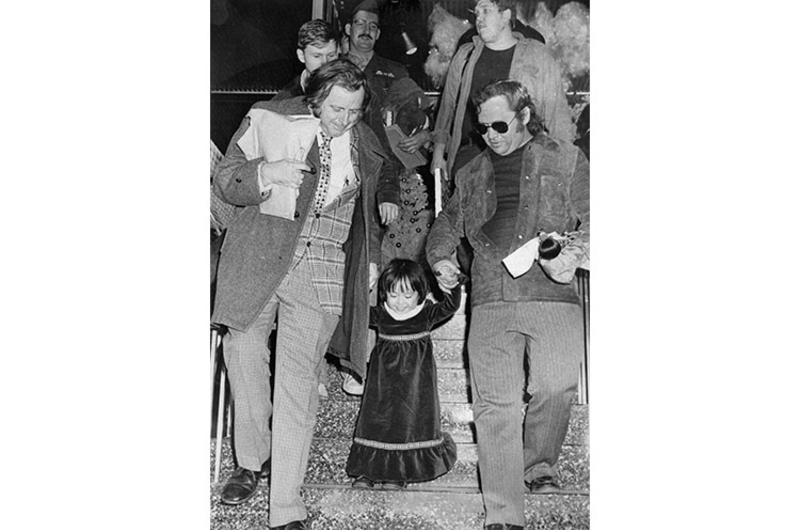
A beaming Kim Yon Jin - now Jenny Jones - is led down a stairway at Tokyo International Airport Tuesday by Pacific Stars and Stripes Hal Drake (left) and Jim Lea. The tiny Korean girl, adopted last year by Mr. and Mrs. Ronald Jones of Norristown, Pa., was en route home after stories of her plight in Stripes led to cutting of red tape by immigration officials to get her to her home in time for Christmas. Escorting Jenny from Seoul to New York is Gunnery Sgt. Mike Rush (in rear with mustache) Stripes' Korea Bureau chief. Also greeting Jenny were two other Stripes staffers, Sgt. William McCallum (behind Drake) and PO 2C. Calvin McGuire. 12/26/1975
Stars and Stripes was meant to be a GI’s newspaper, so it should come as no surprise that many of the publication’s standout journalists were active-duty service members. Stars and Stripes’ Pacific staffers went on to work for “60 Minutes,” draw for Marvel Comics and snap photos for Life magazine. Here’s a sampling of the bureau’s brightest stars, both civilian and military.
Shel Silverstein
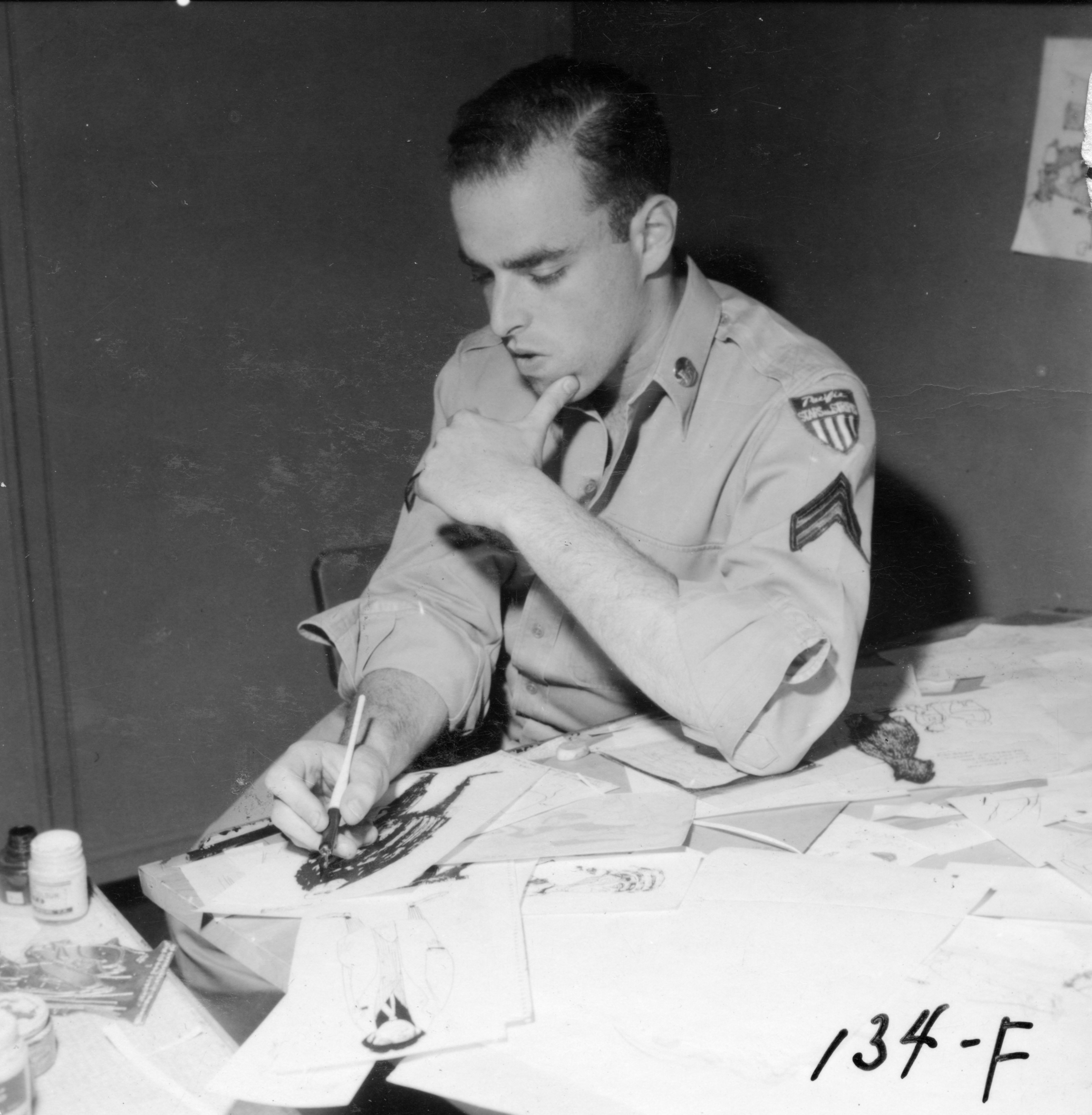
Author, composer and Playboy cartoonist Shel Silverstein served as a draftee on Stars and Stripes’ Pacific staff in the mid-1950s and said it was the catapult that launched him to success and wealth.
Silverstein wrote and illustrated such children’s classics as “The Giving Tree” and “A Light in the Attic,” but he was only an aspiring cartoonist when he arrived at the newspaper in 1953. He had never done any steady and serious cartooning until he began drawing daily panels about barracks life and field-soldiering.
"For a guy of my age and with my limited experience to suddenly have to turn out cartoons on a day-to-day deadline, the job was enormous,” he told Stripes in 1969. "It was a great opportunity for me, and I blossomed.”
Silverstein became world famous for his cartoons, poetry and songs, such as the Grammy-winning “A Boy Named Sue” recorded by Johnny Cash. He recalled a Stripes cartoon that almost caused a collision with the Uniform Code of Military Justice.
Drawing a page of cartoons for April Fool's Day, he sketched a soldier holding out a mess kit with a slab of toast in it. A cook splashed dark matter over it, saying: "Today, it really is.”
The managing editor, required to inspect all Silverstein cartoons before they were printed, called him over and asked, "Shel, what does this mean?
"Well, you know, powdered milk, powdered eggs. Today it's the real thing. April Fool! Get it?”
That editor approved the cartoon. Many readers gasped over their breakfast on April Fool's Day. Or as one of Silverstein's contemporaries with the newspaper put it at the time: "That cartoon, shingle and all, flew in and out of the fan for several days.”
After leaving the Army, Silverstein struggled as a cartoonist until he heard about Hugh Hefner, who was putting together the first Playboy. Hefner hired Silverstein, who literally moved from ground floor to an executive suite in the Playboy Mansion.
Silverstein died of a heart attack in May 1999 in Key West, Fla. He was 68.
-----
Tom Sutton

Long before artist Tom Sutton began contributing to Marvel Comics and the popular Warren Publishing series “Vampirella,” he was sharpening his drawing pencil, and his skills, at Stars and Stripes’ office in downtown Tokyo.
The Massachusetts native joined the Air Force in 1955 and was later stationed at a base near Osaka, Japan, before being assigned to the newspaper, where he created a daily strip titled “Johnny Craig,” named after one of his favorite comic book artists.
The sci-fi comic took place in 2058 and followed a rocket pilot whose “quest to find a second Earth leads him into undreamed of dangers among the stars.”
A story published in Stars and Stripes the day “Johnny Craig” debuted said the then-20-year-old Sutton got his start “earning soft drink and malt money by illustrating comics for Weird Science Fiction, Vault of Terror and Starman comic books for $45 per eight-page story while his high school pals were still peddling newspapers for pennies.”
According to “It Crept from the Tomb,” a book on horror comics edited by Peter Normanton, Sutton’s early work received praise from legendary artist Norman Rockwell.
While in high school in the late 1940s, Sutton took a correspondence art course and his assignments were graded by Charles Schulz, who was trying to get “Peanuts” off the ground at the time.
After leaving the Air Force and finishing college in New York, Sutton took his Stars and Stripes comics to Marvel, where they were reviewed by Stan Lee, co-creator of iconic characters like Spider-Man, X-Men and the Incredible Hulk.
“I think he was rather impressed by the fact that I had actually done a daily comic strip for two years,” Sutton told The Comics Journal in 2001. “He just reached over and he pulled off this huge pile of blank paper. And he said, ‘OK, do me a couple of Westerns and I’ll see you next week. Have fun.’ I remember that very well. ‘Have fun.’”
Sutton, best known for his writing and illustration work on the popular “Vampirella” horror series, looked back fondly on his time with Stripes, which he called “my art school.”
“I remember one of the first jobs I got was they wanted me to draw this temple and some GIs or something, and they tossed a couple of photographs on the drawing table, and they said, ‘You’ve got 45 minutes!’ Forty-five minutes?” he told The Comics Journal. “There were men there who had worked at Collier’s, who had worked at Saturday Evening Post, who had worked on various other magazines, you understand what I’m saying? That was real. I don’t think there is anything better than what we used to call on-the-job training or apprenticeship.”
Sutton, who also worked under the pen names Sean Todd, TFS and Dementia, died of an apparent heart attack in May 2002. He was 65.
-----
Steve Kroft
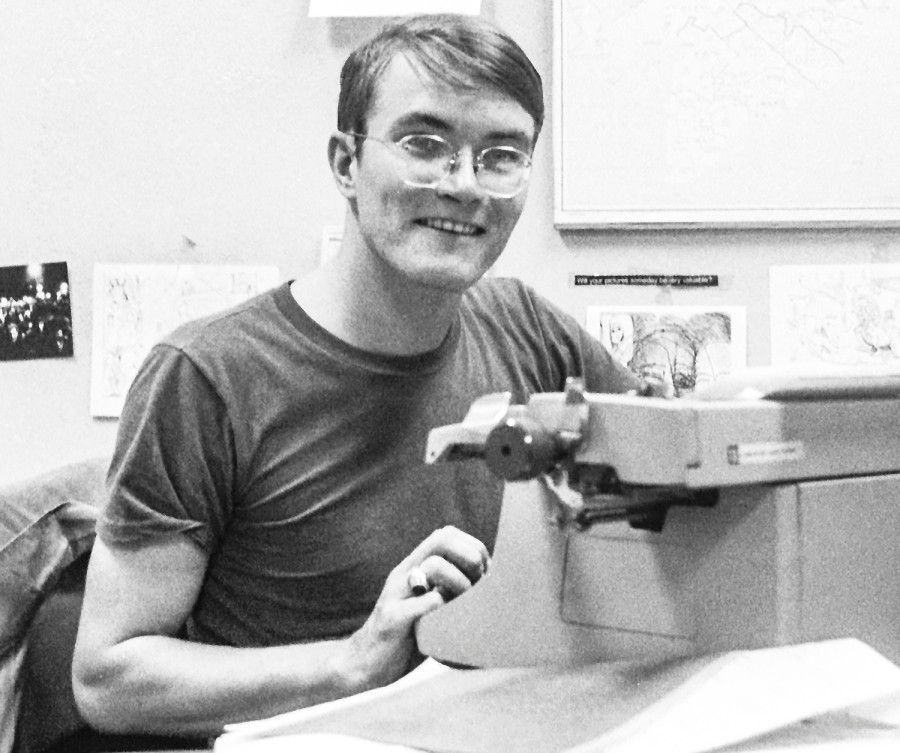
John Mueller ©Stars and Stripes
Veteran broadcaster Steve Kroft, who retired from CBS-TV’s “60 Minutes” in 2019 after three decades with the groundbreaking news program, began his journalism career with Stars and Stripes Pacific during the Vietnam War.
Kroft, 74, broke into news as a correspondent and photographer while serving in the Army in Vietnam.
“[Stars and Stripes] would be the thing that I really wanted to do, and I felt it was something that would show up on my résumé and that I would be proud to have on my résumé,” he said in October 2018 at the Washington, D.C., premier of a documentary film on the newspaper, which he narrated.
Following his military service, Kroft earned a master’s degree from Columbia Journalism School and worked for local television stations in Jacksonville, Fla., and Miami before joining CBS News in 1980.
He was transferred to New York in 1987 as principal correspondent for “West 57th,” a news magazine that led to his assignment on “60 Minutes.”
He won his first of five Peabody Awards for a 1990 critical look at how the military disciplined an experienced officer for a friendly fire incident. His interview with President-elect Barack Obama drew more than 25 million viewers in November 2008 and remains the largest "60 Minutes" audience since 1999.
Kroft was the longest-tenured reporter for “60 Minutes,” which was created by fellow Stripes alumnus Don Hewitt and for years featured another, Andy Rooney.
His numerous citations include the Investigative Editors and Reporters Award, the George Polk and JFK Journalism Awards and a Lifetime Achievement Emmy Award.
-----
John Olson
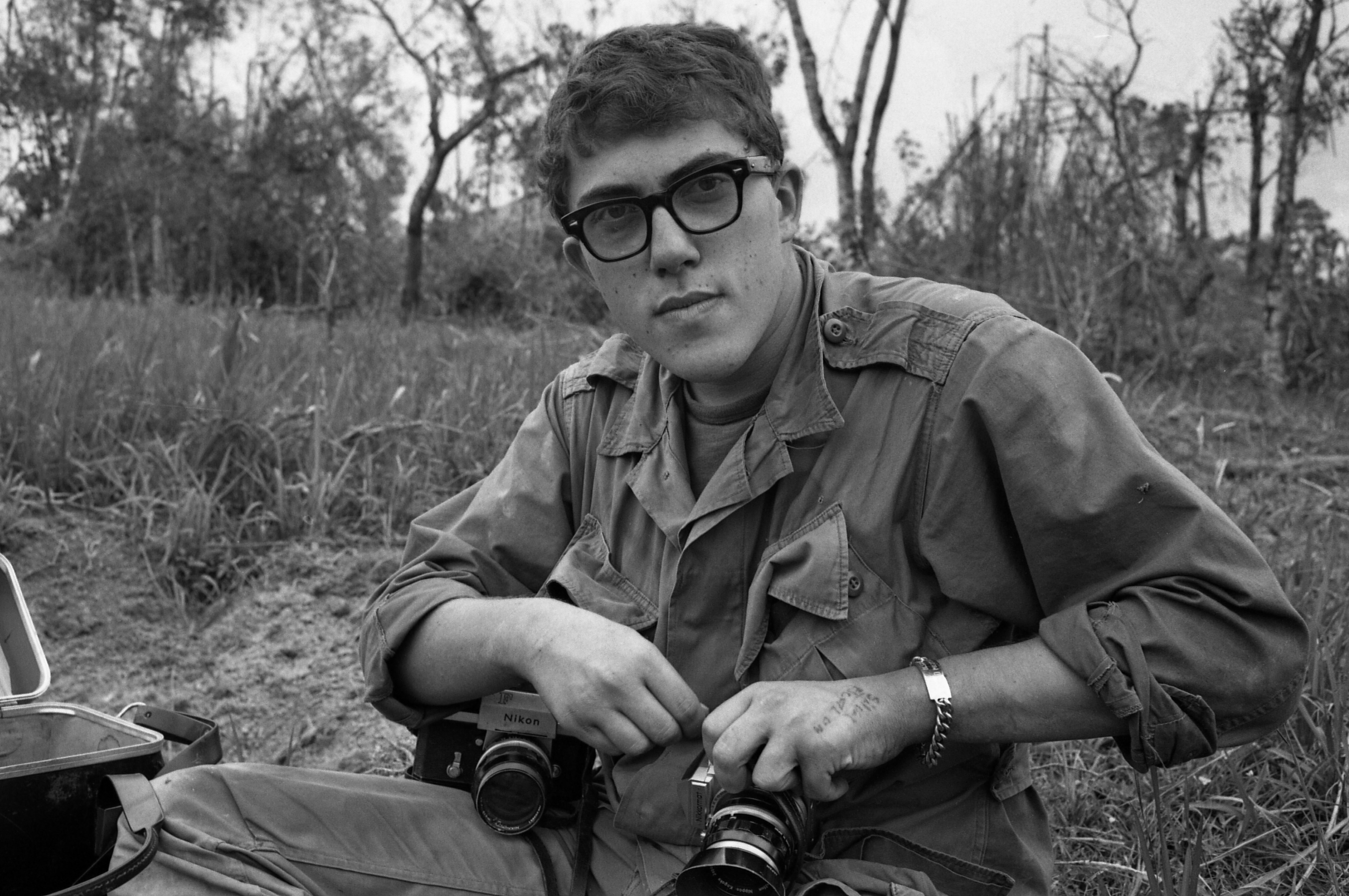
Former Stars and Stripes Pacific combat photographer John Olson is known for his haunting images of the Vietnam War, particularly those taken during the bloody Tet Offensive and Battle of Hue in 1968.
“I was a highly motivated photojournalist,” he told the newspaper in 2018. “I’d been in Vietnam for a year, and if you are a combat photographer, you can’t fake it. The more dangerous the better, and I learned that the heaviest fighting was at Hue. So, I went to Hue.”
The powerful photographs Olson took as he followed the 1st Battalion, 5th Marine Regiment through Hue have often been credited with playing a role in America’s eventual withdrawal from the war.
“They were published in Stars and Stripes and also Life magazine,” said Olson of those images, which earned him the prestigious Robert Capa Gold Medal. The award is given by the Overseas Press Club of America for the “best published photographic reporting from abroad requiring exceptional courage and enterprise.”
The March 1968 issue of Life featured a six-page spread of Olson’s photos titled “The Battle that Regained and Ruined Hue.” After leaving the Army, he became the publication’s youngest-ever staff photographer.
“Like many veterans, I came back from Vietnam and I spent decades not talking about it,” he said. “But as we approached the 50th anniversary of the Tet Offensive and the Battle of Hue, I began to wonder what had happened to the young men I’d photographed.”
Olson was able to track down nearly a dozen of those Marines, interview them and capture their harrowing stories on tape.
“They told me about their time in Hue and how the years since Hue have affected their lives,” he said. “How the battle and the fighting – what impact it had on them.”
Olson eventually turned this personal project into an exhibit called “The Marines and Tet,” which ran at the Newseum in Washington, D.C., to mark the battle’s 50th anniversary in 2018.
The Washington Post described the exhibit’s centerpiece photo this way: “The picture – the most important he’s ever taken – shows a half dozen Marines sprawled atop a mud-crusted tank. One man’s arm and eye are bandaged.
Blood coats another’s legs. In the foreground, a third man lays atop a wooden door his comrades used as a makeshift stretcher. His shirt has been ripped off because, in the center of his chest, is a bullet hole.”
Olson told the newspaper he had “next to no memory” of taking that photo. When he was asked how the Vietnam War had affected him, the photographer didn’t have an answer.
“I don’t have all that figured out yet,” he said.
-----
Vernon Grant

Cartoonist and Army officer Vernon Grant had a unique ability to capture the soldier’s perspective during the Vietnam War.
“One Vietnam veteran said to me, ‘We had some terrible times in Vietnam, but we also laughed a lot,” Grant’s widow, Betsy Grant, told Stars and Stripes during a recent phone interview. Grant’s work “will make you laugh. His sense of humor was universal for all soldiers.”
The youngest of five children in a family that immigrated to Massachusetts from Barbados, Grant was 23 when he joined the Army in 1958, with segregation still a dehumanizing force in the United States. Two years in, he was invited to enroll in the Infantry Officer Candidate Course at Fort Benning, Ga., and was commissioned a second lieutenant.
Grant made captain in 1966 and went to Vietnam a year later, where he commanded the Signal Security Force, 400 men guarding 23 communications sites scattered the length of Vietnam.
Between 1966 and 1969, Grant drew comics for Stars and Stripes, under the titles “Grant’s Heroes,” “A Grant Time in Japan” and “Grant’s Grunts.” They were biting and humorous but offered a window into the soldier’s experience in Vietnam.
In one strip, a two-star general looks up at a man sitting on an elevated throne and say, “If you don’t mind coming down, Colonel … I’ll give you my ten-minute thing on ‘Command Modesty!’”
“He used exaggeration really well,” Betsy Grant said.
Grant left the military in 1968, after 10 years of service. He enrolled in classes at Jesuit Sophia University, which had a campus in Tokyo. He wrote three books on Army life and one on Japan: a two-volume graphic novel “Adventures of Point-Man Palmer and his Girlfriend ‘Invisible Peppermint,’” “Stand-By One!” and “A Monster is Loose! – in Tokyo.”
He told reporters in 1977 that his popularity among front-line soldiers was a bit overwhelming.
“I became an institution for the U.S. GIs who sought comic relief from the danger of combat and the boredom of army life,” he told the Cambridge Chronicle weekly in Massachusetts. “More soldiers read my books than any other cartoonist or writer in the front. I still get embarrassed when I meet someone on the street who recognizes me.”
He suffered a heart attack on a run July 7, 2006, fell into a coma and died weeks later.
“His creations of the stories of ‘Point-Man Palmer’ and cartoons in the military field as well as his science fiction world of ‘The Love Rangers’ are his legacy,” his widow wrote in her book.
Speaking with Stars and Stripes in 1972, Grant made his intentions abundantly clear. He just wanted to make people laugh.
“Translating life into humor is the biggest thing with me,” he said at the time.
-----
Hal Drake
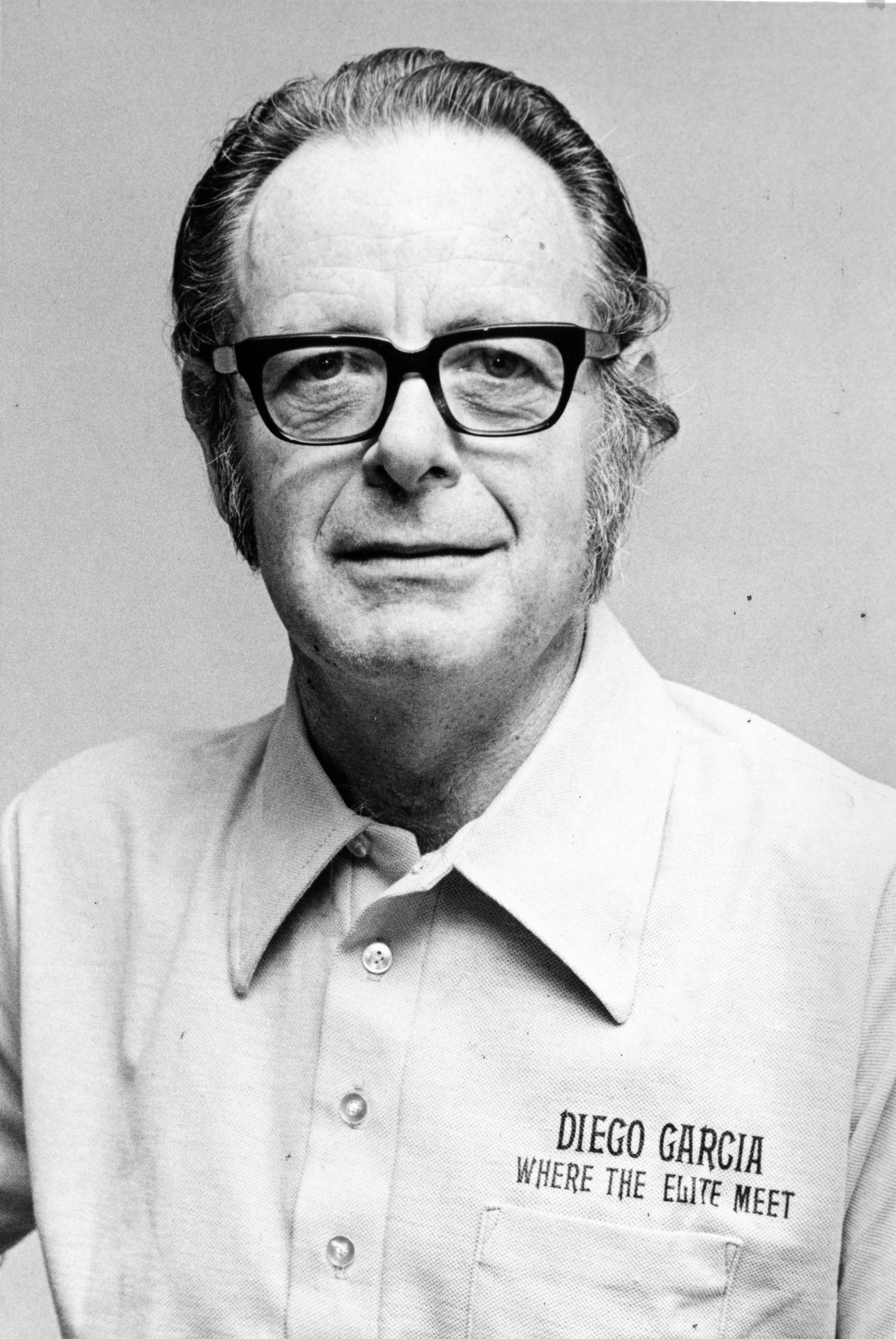
During his nearly four decades with Stars and Stripes, Hal Drake covered everything from high-level summits and the release of POWs from Vietnam to Muhammad Ali and high school sports.
A native of Santa Monica, Calif., Drake served 10 months in the Korean War as an artilleryman, viewing up close the carnage on Heartbreak Ridge. He applied for one of a handful of reporting jobs at Stars and Stripes and joined the Pacific staff in July 1956.
Until his retirement on Dec. 31, 1995, Drake worked as a reporter, then later as senior writer and columnist. He traveled four times to Vietnam during the war, and later returned with freelance photographer Jim Bryant in April 1985 for the 10th anniversary of the end of the war.
He was at Clark Air Base, Philippines, in February 1973 to greet returning POWs released from Vietnam.
Every president, “Ford through Clinton – I think I got them all when they came over here,” Drake once said. He was equally comfortable quizzing rock musicians such as Rod Stewart about their choice of song lyrics.
“He managed to find the human element in everything he wrote. And he was always a gentleman in the process,” said former Pacific Stripes news editor Ron Rhodes.
Drake marched to his own drummer, his former co-workers said.
“Hal’s desk — a pile of thousands of papers nearly three feet tall — was the stuff of newspaper legend,” said former colleague Adam Johnston, who was assigned to Stripes from 1993-99 while in the Air Force.
Drake could often be seen wandering the newsroom twirling and eyeing an elongated band of wire called a whirligig.
“He was quirky, but always fun and always smart,” said Gerry Galipault, who worked in the Tokyo office from 1984-90. When working the whirligig, “you could tell his mind was working a mile a minute, thinking about what to write next, what to say. And he always said it beautifully.”
After leaving Stripes, Drake and his wife, Kaz, retired to the Gold Coast in Queensland, where they helped run an international student exchange program.
After a lengthy battle with stomach cancer, Drake died there in 2013 at age 83.
-----
Shelley Smith

Shelly Smith, now a correspondent for ESPN’s SportsCenter, was hired by Stars and Stripes in late winter 1982, arriving in Tokyo to become the first full-time civilian woman staffer on the previously all-male sports desk.
It was a time when glue pots and blue pencils were on their way out, computers were taking over the business and cable news was in its infancy.
It was also an era when Stripes covered major national and international sports events in the Pacific, not just what happened on the bases.
“It was the most glorious of times and I still believe I did a service for our troops,” Smith recently told the newspaper. “There was no CNN, no USA Today … How else were they to find out if Duke beat North Carolina?”
Smith was one of the first reporters to greet Clemson’s football team for the 1982 Mirage Bowl in Tokyo and question Tigers coach Danny Ford about the NCAA probation just handed his team. She also interviewed a young William “Refrigerator” Perry, who played for Clemson and went on to win a Super Bowl with the Chicago Bears.
“We had so much fun; we were so young and ready to take on the world,” Smith said of her days at Stripes. “Our staff was so devoted. We traveled near and far to bring great stories to our readers.”
After her time with Stripes, Smith joined the San Francisco Examiner and won a William Randolph Hearst Award in 1986 for her series on Title IX in the Bay Area.
In her early days with ESPN, which she joined in 1993, she won a Sports Emmy for her segment on Magic Johnson as part of an ESPN production on AIDS and athletes. She also worked for The Associated Press.
Smith has also authored two books, “Just Give Me the Damned Ball!” written with former NFL receiver Keyshawn Johnson, and “Games Girls Play: Lessons to Guiding and Understanding Young Female Athletes,” written with sports psychologist Carolina Silby and released in 2000.
Smith is a breast-cancer survivor, and was named co-winner of the Sports Illustrated sports media Person of the Year award, along with the late Craig Sager, longtime NBA sideline reporter for Turner Network Television.
Smith also survived a stroke, suffered in May 2017 in the Golden State Warriors locker room after Game 1 of the NBA Western Conference finals, and updated her progress on her Twitter account.


